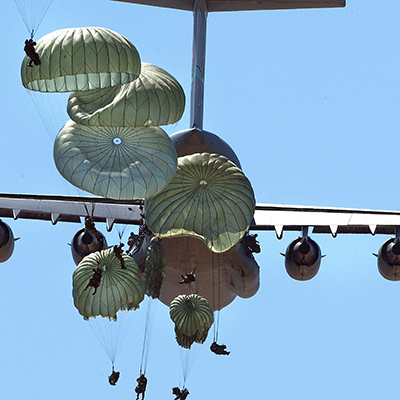Terms & Concepts
Airborne Operations
Mohsen Shir-Muhammad
64 Views
Airborne operations refer to the transportation of troops and supplies by air during wartime missions. During the Iran-Iraq War, airborne operations were sometimes used to move troops into key areas, depending on the situation in each region.
Airborne operations, also known as air assaults,[1] involve the movement and landing of combat troops and support units by air directly into the target area to carry out military missions.[2] These operations are conducted in coordination with ground, air, and—when necessary—naval forces.[3] There are three primary methods of airborne deployment: by parachute, glider or helicopter, and transport aircraft.
Parachute drops are the most common form of airborne operation. Soldiers who are deployed this way are known as paratroopers. The Soviet Union was the first country to establish such a force in 1930.[4] The French Army used this method extensively in the Vietnam War in 1953, and the Israeli military employed similar tactics during the 1956 war with Egypt.[5]
The second method, once carried out using gliders (motorless aircraft), was phased out after World War II and replaced by helicopters in modern operations. The third method involves landing troops using transport aircraft. However, it is rarely used due to high risks when landing and the requirement for proper airstrips. The German army used this tactic in 1940 to seize Oslo Airport in Norway.[6]
One of the largest airborne operations in history took place in 1944 during the Normandy invasion, involving 156115 American, British, and Canadian troops. The operation included 6939 military ships and landing craft, 3952 aircraft, and 867 gliders to transport airborne forces.[7]
During the eight-year Iran-Iraq War, the first and third methods were largely avoided due to terrain challenges and obstacles placed by enemy forces. For example, after occupying Khorramshahr, Iraqi forces installed metal poles and other barriers around the city to prevent Iranian paratroopers from landing.[8]
Only a few airborne operations were carried out using helicopters. One example is the airlift of the 153rd Battalion of the 77th Khorasan Division by Navy-operated helicopters from Mahshahr to Abadan, after the city was besieged by Iraqi forces.[9] This operation resulted in direct engagement with Iraqi troops in the Zolfaqari area on October 31, 1980, and played a key role in preventing the fall of Abadan.[10]
The largest airborne operation during the Iran–Iraq War took place in Operation Kheibar in February 1984. A significant number of helicopters of the Army Aviation (Havanirooz), Air Force, and Navy participated in this mission under the command of Havanirooz. The pilots involved had received special training, including night-flying techniques.[11]
Throughout the operation, 19400 troops were airlifted to the Majnoon islands using 98 helicopters.[12] After eight consecutive days of intense fighting, the operation concluded with the successful capture of the islands.[13]
March 1985 saw another major airborne effort during Operation Badr, as Iranian forces advanced on Majnoon Island to seize control of the remaining part of Hoor al-Azim. In this operation, 7165 fighters were transported to the frontlines using 50 Havanirooz helicopters.[14]
Recognizing the strategic importance of airborne operations in military campaigns, Iran’s armed forces have continued to strengthen their military capabilities since the end of the war. Through various drills and exercises, they have significantly enhanced their operational readiness for future airborne missions.[15]
[1] Azmi, Mahmoud, Niroohaye Havabord-e Rezhim-e Sehyonisti (Airborne Forces of the Zionist Regime), Tehran: Daftar-e Motaleat-e Siasi va Beynolmelali, 2nd ed., 1370, p. 11.
[2] Mahname-ye Saf (Saf Monthly), No. 11, Mehr 1359, p. 31.
[3] Rostami, Mahmoud, Farhang-e Vazhehhaye Nezami (Military Terminology Dictionary), Tehran: Iran Sabz, 1386, Pp. 593, 905.
[4] Azmi, Mahmoud, Ibid., Pp. 11–13, 15–16.
[5] Giap, Vo Nguyen, Dien Bien Phu, trans. Hamid Azimi, Tehran: Ettelaat, 1376, p. 82; Nejati, Gholamreza, Jang-e Shesh Roozeh (The Six-Day War), Tehran: Moassese-ye Matbooati-ye Ataei, 1347, p. 52.
[6] Azmi, Mahmoud, Ibid., Pp. 13, 15–16.
[7] Websayt-e Rooznameh-ye Khorasan (Khorasan Newspaper Website): www.khorasannews.com/newspaper/695606
[8] Khedri, Reza, Khorramshahr az Esarat ta Azdi (Khorramshahr: From Captivity to Liberation), Tehran: Daftar-e Nashr-e Farhang-e Eslami, 4th ed., 1374, p. 179.
[9] Shir-Muhammad, Mohsen, Barfaraz-e Daryaha (Above the Seas), Tehran: Daftar-e Pazhuheshha-ye Nazari va Motaleat-e Rahbordi-ye Niroo-ye Daryai, 1400, Pp. 161–165.
[10] Sarvari, Rouhollah & Javedani, Abolqasem, Amaliat-e Thamen al-Aemmah (as) (Operation Thamen al-Aemmah (as)), Tehran: Nashr-e AJA, 1390, p. 70.
[11] Kheibarshekanan: Vizhenameh-ye Salgard-e Nabard-e Azim-e Kheibar (Kheibarshekanan: Special Issue for the Anniversary of the Great Battle of Kheibar), No. 2, Esfand 1386, p. 75.
[12] Karimzadeh, Ardeshir, Hamaseha-ye Mandegar-e Havanirooz dar Defa Muqaddas (Enduring Epics of Army Aviation in the Sacred Defense), Tehran: Novid Tarahan, 1388, Pp. 100–101.
[13] Jafari, Mojtaba, Atlas-e Nabardha-ye Mandegar (Atlas of Lasting Battles), Tehran: Sooreh Sabz, 1389, p. 96.
[14] Ibid., p. 104; Soltani, Morteza, Havanirooz va Hamaseh-ye Bozorg-e Badr (Army Aviation and the Great Badr Epic), Tehran: Sooreh Sabz, 2nd ed., 1389, p. 18.
[15] Mahname-ye Saf (Saf Monthly), No. 419, Esfand 1394 – Farvardin 1395, Pp. 60–65.





